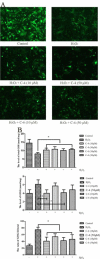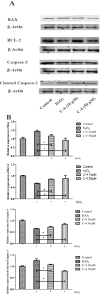Protective effect of bioactive compounds from Lonicera japonica Thunb. against H2O2-induced cytotoxicity using neonatal rat cardiomyocytes
- PMID: 27096070
- PMCID: PMC4823622
Protective effect of bioactive compounds from Lonicera japonica Thunb. against H2O2-induced cytotoxicity using neonatal rat cardiomyocytes
Abstract
Objectives: Pharmacological studies showed that the extracts of Jin Yin Hua and its active constituents have lipid lowering, antipyretic, hepatoprotective, cytoprotective, antimicrobial, antibiotic, antioxidative, antiviral, and anti-inflammatory effects. The purpose of the present study was to investigate the protective effects of caffeoylquinic acids (CQAs) from Jin Yin Hua against hydrogen peroxide (H2O2)-induced and hypoxia-induced cytotoxicity using neonatal rat cardiomyocytes.
Materials and methods: Seven CQAs (C1 to C7) isolated and identified from Jin Yin Hua were used to examine the effects of H2O2-induced and hypoxia-induced cytotoxicity. We studied C4 and C6 as preventative bioactive compounds of the reactive oxygen species (ROS) production, apoptotic pathway, and apoptosis-related gene expression.
Results: C4 and C6 were screened as bioactive compounds to exert a cytoprotective effect against oxidative injury. Pretreatment with C4 and C6, dose-dependently attenuated hypoxia-induced ROS production and reduced the ratio of GSSG/GStotal. Western blot data revealed that the inhibitory effect of C4 on H2O2-induced up and down-regulation of Bcl-2, Bax, caspase-3, and cleaved caspase-3. Apoptosis was evaluated by detection of DNA fragmentation using TUNEL assay, and quantified with Annexin V/PI staining.
Conclusion: In vitro experiments revealed that both C4 and C6 protect cardiomyocytes from necrosis and apoptosis during H2O2-induced injury, via inhibiting the generation of ROS and activation of caspase-3 apoptotic pathway. These results demonstrated that CQAs might be a class of compounds which possess potent myocardial protective activity against the ischemic heart diseases related to oxidative stress.
Keywords: Anti-apoptosis; Caffeoylquinic acids; Cardiomyocytes; Lonicera japonica Thunb; Oxidative stress.
Figures





Similar articles
-
Shengmai injection alleviates H2O2‑induced oxidative stress through activation of AKT and inhibition of ERK pathways in neonatal rat cardiomyocytes.J Ethnopharmacol. 2019 Jul 15;239:111677. doi: 10.1016/j.jep.2019.01.001. Epub 2019 Jan 4. J Ethnopharmacol. 2019. PMID: 30615921
-
Chlorogenic acid analogues from Gynura nepalensis protect H9c2 cardiomyoblasts against H2O2-induced apoptosis.Acta Pharmacol Sin. 2016 Nov;37(11):1413-1422. doi: 10.1038/aps.2016.79. Epub 2016 Sep 5. Acta Pharmacol Sin. 2016. PMID: 27593219 Free PMC article.
-
Rutin from Lonicera japonica inhibits myocardial ischemia/reperfusion-induced apoptosis in vivo and protects H9c2 cells against hydrogen peroxide-mediated injury via ERK1/2 and PI3K/Akt signals in vitro.Food Chem Toxicol. 2009 Jul;47(7):1569-76. doi: 10.1016/j.fct.2009.03.044. Epub 2009 Apr 9. Food Chem Toxicol. 2009. PMID: 19362115
-
25-Hydroxyl-protopanaxatriol protects against H2O2-induced H9c2 cardiomyocytes injury via PI3K/Akt pathway and apoptotic protein down-regulation.Biomed Pharmacother. 2018 Mar;99:33-42. doi: 10.1016/j.biopha.2018.01.039. Epub 2018 Jan 8. Biomed Pharmacother. 2018. PMID: 29324310
-
Pretreatment of MQA, a caffeoylquinic acid derivative compound, protects against H2O2-induced oxidative stress in SH-SY5Y cells.Neurol Res. 2016 Dec;38(12):1079-1087. doi: 10.1080/01616412.2016.1245030. Epub 2016 Nov 1. Neurol Res. 2016. PMID: 27800716
Cited by
-
Unrevealing the mechanisms behind the cardioprotective effect of wheat polyphenolics.Arch Toxicol. 2024 Nov;98(11):3543-3567. doi: 10.1007/s00204-024-03850-y. Epub 2024 Aug 31. Arch Toxicol. 2024. PMID: 39215839 Review.
-
Chlorogenic Acid: A Systematic Review on the Biological Functions, Mechanistic Actions, and Therapeutic Potentials.Nutrients. 2024 Mar 23;16(7):924. doi: 10.3390/nu16070924. Nutrients. 2024. PMID: 38612964 Free PMC article.
-
Dissecting the Underlying Pharmaceutical Mechanism of Chinese Traditional Medicine Yun-Pi-Yi-Shen-Tong-Du-Tang Acting on Ankylosing Spondylitis through Systems Biology Approaches.Sci Rep. 2017 Oct 18;7(1):13436. doi: 10.1038/s41598-017-13723-3. Sci Rep. 2017. PMID: 29044146 Free PMC article.
-
Therapeutic Potential of Chlorogenic Acid in Chemoresistance and Chemoprotection in Cancer Treatment.Int J Mol Sci. 2024 May 10;25(10):5189. doi: 10.3390/ijms25105189. Int J Mol Sci. 2024. PMID: 38791228 Free PMC article. Review.
-
Comparison of Multiple Bioactive Constituents in the Flower and the Caulis of Lonicera japonica Based on UFLC-QTRAP-MS/MS Combined with Multivariate Statistical Analysis.Molecules. 2019 May 20;24(10):1936. doi: 10.3390/molecules24101936. Molecules. 2019. PMID: 31137485 Free PMC article.
References
-
- Hayes O. Fact sheet: cardiovascular disease (ICD-9 390-448) and women. Chronic Dis Can. 1996;17:28–30. - PubMed
-
- Sun HY, Wang NP, Kerendi F, Halkos M, Kin H, Guyton RA, et al. Hypoxic postconditioning reduces cardiomyocyte loss by inhibiting ROS generation and intracellular Ca2+ overload. Am J Physiol Heart Circ Physiol. 2005;288:H1900–908. - PubMed
LinkOut - more resources
Full Text Sources
Research Materials
Miscellaneous
